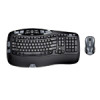Logitech Desktop Wave Making of Wave - Page 3
The Actual Shape of the Human Hand, The Specifications of Comfort - cordless
 |
View all Logitech Desktop Wave manuals
Add to My Manuals
Save this manual to your list of manuals |
Page 3 highlights
Creating Comfort: The Making of the Logitech Comfort Wave Design - Page 3 The Actual Shape of the Human Hand With the four points of discomfort in mind, Sauvage began examining the human hand and its natural resting position. He noticed that when we place our hands on a straight keyboard, our hands actually take the shape the keyboard guides them into. Sauvage began to think about the basic concepts behind designing a keyboard for the natural shape and resting position of the hands. One of the defining moments came when Sauvage was Figure 1 Pin art playing with a pin-art toy, which uses metal pins to capture the three-dimensional shape of any object placed against it. Sauvage pressed his hand onto the pin-art toy and saw the outline of his hand. And he realized what had always been apparent but never explored and commercialized in keyboard design: each of our fingers is a different length. Logitech could create a more comfortable keyboard by shaping the key frame to fit the variable vertical length of the fingers, by offering a key frame that mirrored the actual shape of the human hand. From that moment, Sauvage began to feel confident about an innovative design - a wave-shaped key frame that would mirror the actual varying length of the fingers. A keyboard design with the potential to bring comfort to the masses. The Specifications of Comfort To determine the specific variations in height of each key, from late September 2005 until March 2006, Sauvage worked with a team of industrial engineers at a U.S. university. Using design analysis and prototype testing, Sauvage was able to determine the ideal contour for what would become the signature element of the Logitech Comfort Wave Design. He began by creating three-dimensional renderings that mapped a wave-shaped key frame onto an image of an existing keyboard - the Logitech® Cordless Desktop® MX™ 5000. They created drawings of each keyboard row and reviewed several options with various heights for each key. Finally, they created four prototypes and analyzed the perceived comfort of each design. After testing and reviewing the results, Sauvage arrived at a critical decision, establishing that the ideal height differential between the lowest and highest key should be 4 mm. A smaller height - 2 mm or 3 mm - was too subtle. A higher one - 5 mm - was too drastic. Finding the right balance between what usability experts call the perceived and actual comfort would prove to be a critical decision. The peaks and troughs of the Wave key frame would rise and fall but never exceed a height differential of more than 4 mm. But the new keyboard would need to offer more than just an innovative key frame. To achieve Logitech's goal of providing a comfort keyboard for everyone, Sauvage knew










